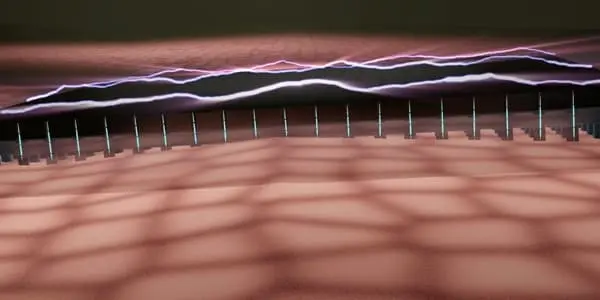A silicon device capable of transforming skin tissue into blood vessels and nerve cells has progressed from prototype to standardized fabrication, implying that it can now be manufactured in a consistent and reproducible manner. This work, developed by researchers at Indiana University School of Medicine, brings the device one step closer to potential use as a treatment for people with a variety of health concerns, according to Nature Protocols.
Tissue nano transfection is a non-invasive nanochip device that can reprogram tissue function by delivering specific genes in a fraction of a second using a harmless electric spark. The device successfully converted skin tissue into blood vessels in laboratory studies to repair a badly injured leg. Currently, the technology is being used to reprogram tissue for various therapies, such as repairing brain damage caused by stroke or preventing and reversing nerve damage caused by diabetes.
“This report on how to precisely produce these tissue nano transfection chips will allow other researchers to participate in this new development in regenerative medicine,” said Chandan Sen, director of the Indiana Center for Regenerative Medicine and Engineering, associate vice president for research, and Distinguished Professor at the Indiana University School of Medicine.
This small silicon chip enables nanotechnology, which can alter the function of living body parts. For example, if someone’s blood vessels were damaged in a car accident and they require blood supply, we can’t rely on the pre-existing blood vessel because it’s crushed, but we can convert skin tissue into blood vessels and save the limb at risk.
Chandan Sen
Sen also directs the IU Precision Health Initiative’s regenerative medicine and engineering scientific pillars and is the lead author on the new publication. “This small silicon chip enables nanotechnology, which can alter the function of living body parts,” he explained. “For example, if someone’s blood vessels were damaged in a car accident and they require blood supply, we can’t rely on the pre-existing blood vessel because it’s crushed, but we can convert skin tissue into blood vessels and save the limb at risk.”
The researchers published engineering details about how the chip is manufactured in the Nature Protocols report. Sen stated that this manufacturing information will lead to further development of the chip in the hopes that it will be used clinically in many settings around the world someday.
“This is about the chip’s engineering and manufacturing,” he explained. “The chip’s nano fabrication process typically takes five to six days and can be accomplished by anyone skilled in the art,” according to the report.

Sen stated that he hopes to apply for FDA approval for the chip within a year. Once approved by the FDA, the device could be used for clinical research in humans, including patients in hospitals, health centers, and emergency rooms, as well as first responders or the military in other emergency situations.
Stem cells have proven to be one of the most important discoveries in recent decades for treating a wide range of diseases. Non-specialized cells can be injected into various parts of the body to replace damaged cells and tissues. They eliminate the need for donors and eliminate the risk of tissue rejection. The laboratory procedures involved in using stem cells, on the other hand, can be quite complex. There are also risks associated with the treatment, such as an increase in the number of cancerous cells.
The new silicon nano-chip technology aims to do away with the need for a laboratory, instead relying on the human body to reprogram biological tissue. Sen and his team have been developing the device for over five years. This technology employs a concentrated electric spark or charge to deliver genes into biological tissue while causing no harm. These genes then go on to change the cells at the site into different cells or structures. The reprogrammed cells may aid in the repair of damage at the site or in another part of the body.
The research report explains how other researchers can manufacture the nano chip device to increase participation in the new regenerative development. Sen hopes that the information will aid in the advancement of the technology.
According to the lead author, the nano fabrication process for making the chip typically takes 5-6 days. Anyone “skilled in the art” can build the device using the information in the report, he claims. Sen hopes that silicon nano chips will one day be used in clinical settings around the world. The team intends to submit an application to the FDA for device approval next year. Once approved, it could be used for clinical research, including in hospitals and during emergencies.
Researchers are currently employing the technology to reprogram biological tissue for a variety of therapies. These include treatments for repairing brain damage caused by a stroke or nerve damage caused by diabetes.




